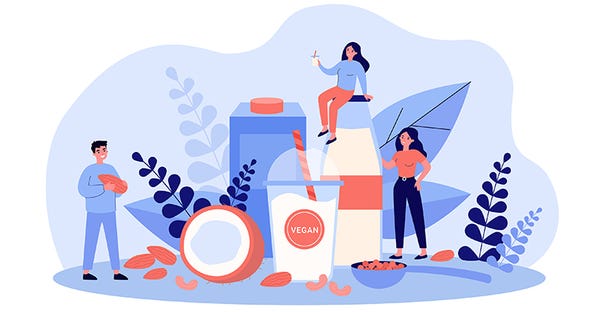
The planets might have us in the Age of Aquarius, but it's the flexitarian age for the natural products industry. Consumers who identify as such—one-third of Americans, according to the Plant Based Foods Association—follow a plant-centric diet while still having the flexibility to consume some meat and dairy.
Author Michael Pollan famously said, "Eat food, not too much, mostly plants." Flexitarians have taken that to heart. This consumer segment continues to grow alongside the meteoric rise of plant-based products, proving this is no longer just a trend but today's preferred way of eating.
And yet, even as consumers embrace all things plant based, many are still just learning about these foods—how to shop for them, how to cook them, and which products are truly healthy and sustainable. At the same time, plant-based product growth has raised a host of new questions for the natural products industry: What constitutes a plant-based product? Are they all created equal? What quality standards should these products uphold? What kinds of plant-based products are consumers buying? Where do they expect to find them in stores? How should natural products retailers market them?
As we move deeper into this new plant-powered world, let's examine seven common assumptions about plant-based products, this fast-growing market and the implications of this evolved style of eating.
Belief: Plant-based food is better for the planet
There's plenty of evidence for the heavy ecological impact of meat consumption. Livestock are responsible for an estimated 14.5% of global greenhouse gas emissions, according to the United Nations Food and Agriculture Organization. Beef cattle account for nearly half of total agricultural emissions in the U.S., a 2019 U.S. Department of Agriculture study found. Furthermore, the Water Footprint Network calculates the global average water footprint of beef at 1,849.2 gallons per pound—much heftier than that of other meats. Beef's water footprint is also 20 times larger per calorie than that of grains and six times larger per gram of protein than that of legumes.
Growing plants in general is much more efficient than raising animals. Therefore, even replacing some animal products in one's diet with plants can have a big environmental impact. Project Drawdown, a nonprofit focused on greenhouse gases, asserts that if 50% of the world's population were to consume about 2,250 calories per day and reduce meat consumption in favor of plant-based foods, it could prevent roughly 65.02 gigatons of cumulative carbon emissions by 2050.
However, not all plant-rich diets carry equal impact. Many of today's plant-based burgers, for example, are a far cry from the traditional small-footprint veggie and bean patties that have long been on natural retail shelves. With much more technology, processing and resources going into many of today's meat replacements, their long-term environmental impact has yet to be quantified.
That said, most of the natural products industry's plant-based brands make sustainability a fundamental part of their missions. Many incorporate upcycling, zero waste and other eco-forward initiatives into their operations while practicing transparency and traceability. Plant-based egg innovator Eat JUST, for example, has developed a proprietary technology that measures individual ingredients on a range of key performance indicators to calculate the overall impact of a product.
While we don't expect consumers to perform lifecycle analyses on each item they buy, we do expect them to make more informed, environmentally aware choices in the future—particularly in the wake of the COVID-19 pandemic. Though health remains the number-one priority of people turning to plant-based products (see belief No. 2), environmental motivations are gaining ground. A June 2020 survey by food innovation firm Mattson indicated that consumers, particularly millennials and Gen Zers, are increasingly choosing plant-based foods because they believe they are better for the environment—up 36% from 2018.
UPSHOT: Plant-based foods are now available in both conventional and natural channels, but natural retailers can continue to differentiate with their high standards and support of mission-based companies. Stock brands that practice sustainability and transparency and/or have organic certification and highlight these values across communications.

Belief: Plant-based products are the healthiest choice
Ample research supports the myriad health benefits of plant-centric diets, including reduced risk of heart disease, obesity and type 2 diabetes. Thus, while nutrition isn't the only driver of the plant-based trend, it's the leading one. According to a September 2020 Gallup poll of consumers who report eating meat less often, rarely or never, 70% ranked health as their top motivation. And in the aforementioned Mattson study, 65% of respondents name health as their primary reason for eating plant-based foods, with aging baby boomers and Gen Xers even more likely to list health first.
Eager to reap the health benefits, some consumers just assume that plant based automatically means nutritious. But again, just as with environmental impact, not all plant-based foods are created equal. In the race to develop more appealing products, particularly as replacements for animal products, some brands prioritize the plant-based attribute over a clean label. This has resulted in an outpouring of processed products boasting amazingly similar tastes and textures to their animal protein counterparts—but often with long and incomprehensible ingredient lists.
"Consumers assume that plant based is a healthier choice, but all of the wisdom, all the research we have about why a plant-forward diet is healthier, that's not what we're seeing replicated in some of today's plant-based foods," says Jessie Shafer, R.D., natural products industry health expert and co-creator of New Hope Network's Plant-Based Burger Taste and Nutrition Analysis Report. "The opportunity to insert nutrition by choosing plant-based ingredients is being stripped away by heavy processing."
Which burger is the most nutritious and delicious? See our test results.
Fortunately, with COVID-19 shining the spotlight on health as never before, the conversation is starting to shift from pure plant-based "meat-too" excitement to questions about processing and ingredients. "We no longer need to go down the route that a plant-based option is a compromise," Shafer says. "It's time to make further strides in nutrition—because consumers are smart. First you capture customers by offering things that will attract people to plant based without making them feel like they're giving things up. Now you have to bring that nutrition element back."
But Shafer also believes the target market for highly processed plant-based products isn't the core natural consumer anyway. Traditional natural-channel shoppers have demanded better-tasting and more convincing plant-based meat and dairy alternatives for years now, and they are less willing to sacrifice on clean labels, real-food ingredients and certifications such as USDA Organic and Non-GMO Project Verified.
UPSHOT: As gatekeepers of health and high standards for their stores, natural grocers bridge the gap between the real and perceived health benefits of plant-based brands. They can assure consumers that the plant-based products on their shelves have been vetted for quality.

Belief: Vegans are driving the plant-based market
Though vegans remain an important part of the market, flexitarians are the ones driving plant-based growth as they enjoy their dairy milk and their oat milk too. According to the Plant Based Food Association, the number of Americans who identify as flexitarians has increased slightly over the previous three years. SPINS puts the number of plant-based eaters even higher, at 39%, and points to the "unprecedented discovery" of plant-based products by new consumers during the pandemic. Data analysis by SPINS and IRI reveals that 2 million new plant-based consumers shopped the category during the early months of the pandemic alone, 30% of whom purchased again.
Innovation and formulation advances mean that natural brands can appeal to these wider flexitarian audiences with plant-based products that look, taste and even perform like their favorite foods. For instance, pioneering vegan brand Miyoko's Creamery has captured a broad customer base by replicating specific dairy cheeses. This strategy can not only boost sales but also further a brand's mission, such as Miyoko's advocacy for the ethical treatment of all animals.
For those who've spent a lifetime dedicated to promoting the vegan lifestyle, seeing non-vegans lured to plant-based products is a huge step forward. "We've heard from Beyond Meat and other companies that the majority of their customers are actually people who also eat meat," says Amber Canavan, senior campaigner for People for the Ethical Treatment of Animals. "So I think that all these products rapidly moving into the space that the animal-derived products used to occupy is just great."
UPSHOT: Following a plant-based diet without sacrificing favorite foods is now easier than ever. This has led to an explosion of plant-based exploration by omnivores who are more focused on wellness than ever before, as well as those who can no longer turn a blind eye to the ethical and environmental issues linked to meat consumption. Retailers should purchase and merchandise with omnivores in mind.

Belief: Plant-based alternatives are just like the real thing
Plant-based innovation may have come a long way, but there are still growing pains as consumers experiment with meat and dairy alternatives. First off, the breadth of choices can be staggering. Plant-based cheeses, for example, could be legume, oat, soy, oil or nut based, each with its own nutritional and organoleptic profile. It might take trial and error for consumers to find which products work best for their needs, dietary tribe, allergies, and taste and texture expectations.
Natural products retailers can remind their customers that embracing plant-based foods is all about exploration and discovering new products to love. Whereas veganism means omitting animal products, plant-based eating can mean adding exciting and beneficial options.
This is definitely the case with plant-based milks. With such a large selection, they have become "and" items rather than "or" products in non-vegan shopping carts. In fact, a 2019 IPSOS survey commissioned by Dairy Management Inc. revealed that 48% of Americans had purchased both dairy and plant-based milks in the prior six months. As other categories, such as plant-based cheese, yogurt and butter, expand in variety and innovation, the same trend might occur.
UPSHOT: Many flexitarians are adding plant-based products to their carts without necessarily taking meat and dairy products away. Retailers can position these items as healthier choices, but also as opportunities for discovery and food adventuring, which should help increase basket sizes.

Belief: Plant-based snacks are always healthy
Like the humble potato chip, many snack foods are inherently plant-based. But in the snack aisle at least, consumers have long understood that plant-based doesn't necessarily mean healthy. With that in mind, where should retailers place premium plant-based snacks that may be similar in format to less-wholesome options but are actually healthy?
To address this issue, five plant-based natural snack brands—Barnana, Biena Snacks, Dang Foods, gimMe and Rhythm Superfoods—formed a coalition in 2020 with the goal of creating a better-for-you snacking set to help shoppers find their products in stores. After all, according to Biena Snacks founder Poorvi Patodia, the people who buy these products typically like to explore, so cross-selling them presents an opportunity for retailers.
"Our data clearly indicates that, when these brands are placed together, retailers literally see a twofold lift in sales across the brands," Patodia says. "There is a set of consumers who are very excited about these kinds of snacks, and when they're dispersed all over the store, we're not capitalizing on the fact that this is someone who would love to discover and buy not just a roasted cauliflower bite but maybe a crispy chickpea with it."
UPSHOT: Better-for-you plant-based options may require more marketing messaging. Smart merchandising can expand the health halo to adjacent brands.

Belief: Natural customers expect to find plant-based products in the produce section
Just like gluten-free products took a while to become fully integrated across store aisles, plant-based foods are still finding their rightful homes. Many, but not all, natural products retailers have already mixed in plant-based milks, butters and yogurts with their dairy counterparts, but the placement of plant-based meats, once a produce section stalwart, is hotly debated by brands, retailers and consumers alike.
When Tofurky launched its Plant-Based Burger in late 2019, the company made a point of staying in the produce section. As CEO Jaime Altos explained to NewHope.com at the time, "Consumers are used to coming to the produce section and finding us, at least in the conventional market, and we built our brand in that produce section, so there's some loyalty there. And out of that loyalty we see a new problem or opportunity within the retail world, which is suddenly that there's interdepartmental competition for market share of plant-based shoppers."
But a lot has changed since then, and other plant-based burger purveyors—particularly those positioned as beef-burger analogues that look, taste and even "bleed" like real meat—have insisted on merchandising their products in the meat case. This approach was a resounding sales success in conventional grocery stores, according to an often-cited study by the PBFA and Kroger, resulting in a 23% average increase in plant-based meat sales among the 60 participating stores.
Although natural-channel consumers are generally more familiar with plant-based products than conventional shoppers, natural retailers could still benefit from this sort of integration strategy. A major challenge, however, is their meat departments tend to be much smaller than those of conventional grocery stores, notes Julie Emmett, senior director of retail partnerships at PBFA. "It can be much harder to commit to the resources it would take to make a shift and [work toward] re-creating store formats," she adds. To this end, PBFA has been working with some of its natural retail partners on redesigning stores, as well as with KeHE to "build optimal schematics and merchandising units and ways that they can support their natural retailers for plant-based," Emmett says.
PBFA's next big merchandising study will focus on plant-based cheese—one of the last plant-based categories typically still segregated in stores. Additionally, the organization recently launched a Retail Merchandising Advisory Council to create a common strategy to help retailers navigate these questions in the future.
UPSHOT: Regardless of how they merchandise, natural retailers still have a lot to offer consumers that conventional stores cannot. "Generally, their assortment is still stronger," Emmett says. "The natural channel is known for plant based as well as organic and all-natural products, so they have that advantage to build upon."

Belief: Plant-based burgers cook up just like beef burgers
Many consumers just assume plant-based burgers should be slapped on the grill or in a pan and voilà!—just like their meaty counterparts. But as preparing 19 different SKUs for New Hope Network's Plant-Based Burger Taste and Nutrition Analysis Report demonstrated, this couldn't be further from the truth. Manufacturers' cooking directions fluctuate tremendously from product to product, technique to technique, so it is crucial to follow them to the letter. Cooking times also vary from 3 to 10 minutes or more.
"Beef burgers are great on the grill because this expedites fat loss, but most plant-based burgers taste best when cooked in some fat, such as avocado oil," Shafer says. "These products are not meant to be cooked dry, which just leeches more fat from the product, giving it a less desirable taste." She suggests retailers educate consumers about the importance of following package directions and even provide recipe suggestions.
While many plant-based beef analogues must be cooked differently than real beef, some other plant-based alternatives can be prepped in similar ways as the real thing. Eat JUST's mung bean–based egg, for example, scrambles remarkably like chicken eggs. And when melted, Miyoko's Creamery's legume–and–oat milk slices look and taste just like real cheddar and pepper jack.
UPSHOT: Retailers can help consumers, particularly those new to plant based, get the most out of their taste experience by walking them through product preparation.
About the Author(s)
You May Also Like
.png?width=700&auto=webp&quality=80&disable=upscale)




